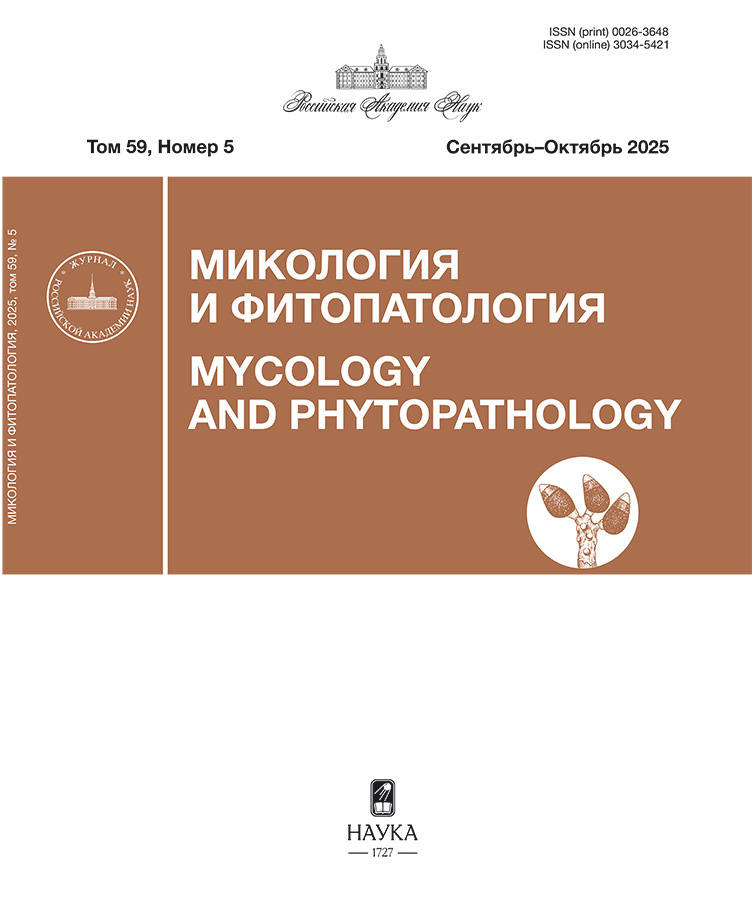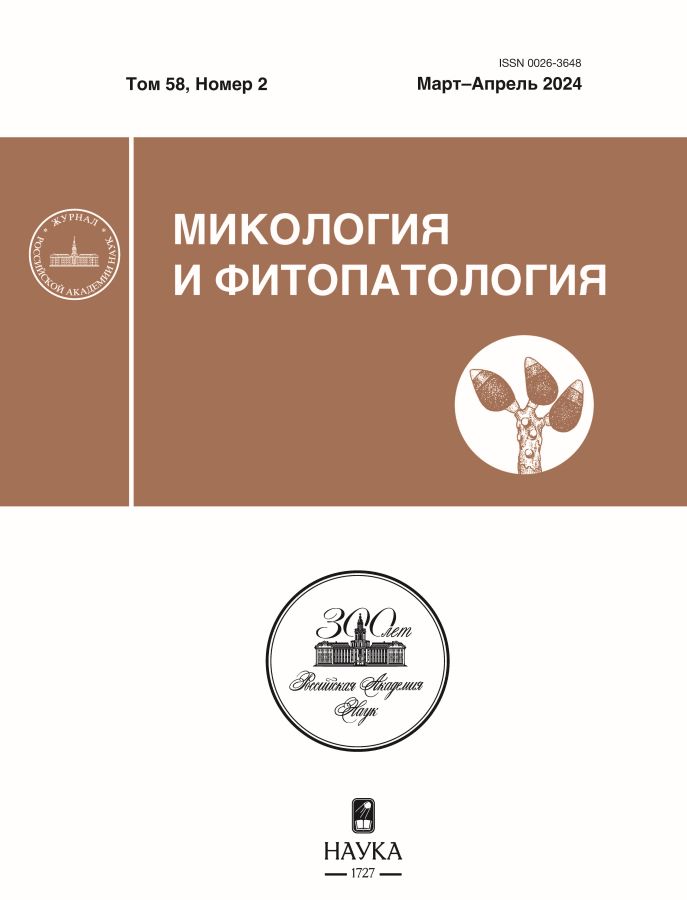Влияние субмикронных частиц оксидов металлов на продукцию пероксида водорода и активность окислительных ферментов Aspergillus niger и Penicillium chrysogenum
- Авторы: Аникина Н.А.1, Барышков Р.В.1, Шишкин А.Ю.1, Смирнова О.Н.1, Смирнов В.Ф.1
-
Учреждения:
- Национальный исследовательский Нижегородский государственный университет им. Н.И. Лобачевского
- Выпуск: Том 58, № 2 (2024)
- Страницы: 134-142
- Раздел: ФИЗИОЛОГИЯ, БИОХИМИЯ, БИОТЕХНОЛОГИЯ
- URL: https://rjraap.com/0026-3648/article/view/655956
- DOI: https://doi.org/10.31857/S0026364824020055
- EDN: https://elibrary.ru/vpaueg
- ID: 655956
Цитировать
Полный текст
Аннотация
Исследовано действие субмикронных частиц оксидов тяжелых металлов WO3, CsTeMoO6 и RbTe1.5W0.5O6, обладающих фотокаталитической активностью, на содержание пероксида водорода и активность экстрацеллюлярных оксидоредуктаз (каталаза, пероксидаза) в среде культивирования грибов Aspergillus niger и Penicillium chrysogenum. Введение в среду культивирования исследуемых соединений снижало содержание Н2О2 для обоих видов. Отмечено неоднозначное действие исследуемых соединений на активность экстрацеллюлярных каталазы и пероксидазы. В большинстве случаев данные соединения вызывали повышение активности исследуемых энзимов как в условиях действия света, так и в темноте. Достоверное снижение активности показано только для экзокаталаз обоих грибов под действием WO3 и под действием CsTeMoO6 у P. chrysogenum.
Полный текст
Об авторах
Н. А. Аникина
Национальный исследовательский Нижегородский государственный университет им. Н.И. Лобачевского
Автор, ответственный за переписку.
Email: undinaf@gmail.com
Россия, 603022 Нижний Новгород
Р. В. Барышков
Национальный исследовательский Нижегородский государственный университет им. Н.И. Лобачевского
Email: romanbariskov1000@mail.ru
Россия, 603022 Нижний Новгород
А. Ю. Шишкин
Национальный исследовательский Нижегородский государственный университет им. Н.И. Лобачевского
Email: uandshi@yandex.ru
Россия, 603022 Нижний Новгород
О. Н. Смирнова
Национальный исследовательский Нижегородский государственный университет им. Н.И. Лобачевского
Email: protectfun@mail.ru
Россия, 603022 Нижний Новгород
В. Ф. Смирнов
Национальный исследовательский Нижегородский государственный университет им. Н.И. Лобачевского
Email: biodeg@mail.ru
Россия, 603022 Нижний Новгород
Список литературы
- Andrés C.M.C., Pérez de la Lastra J.M., Juan C.A. et al. Chemistry of hydrogen peroxide formation and elimination in mammalian cells, and its role in various pathologies. Stresses. 2022. V. 2. P. 256—274. https://doi.org/10.3390/stresses2030019
- Bhanvase B.A., Shende T.P., Sonawane S.H. A review on grapheme-TiO2 and doped grapheme-TiO2 nanocomposite photocatalyst for water and wastewater treatment. Environmental Technol. Reviews. 2017. V. 6. P. 1—14. https://doi.org/10.1080/21622515.2016.1264489
- Daou M., Faulds C.B. Glyoxal oxidases: their nature and properties. World J. Microbiol. Biotechnol. 2017. V. 33 (5). P. 87. https://doi.org/10.1007/s11274-017-2254-1
- Dawson P., Eliot W., John K. Reference biochemist. Mir, Moscow, 1991. (In Russ.)
- Dzambi I., Mangoyi R. The effects of Psidium guajava leaf extract on the production of cellulases and glucose oxidases by Aspergillus niger. GSC Advanced Res. Revs. 2020. V. 5. P. 118—122. https://doi.org/10.30574/gscarr.2020.5.2.0109
- Fukina D.G., Koryagin A.V., Koroleva A.V. et al. Photocatalytic properties of β-pyrochlore RbTe1.5W0.5O6 under visible-light irradiation. J. Solid State Chem. 2021. V. 300. P. 122235. https://doi.org/10.1016/j.jssc.2021.122235
- Fukina D.G., Koryagin A.V., Koroleva A.V. et al. The role of surface and electronic structure features of the CsTeMoO6 β-pyrochlore compound during the photooxidation dyes process. J. Solid State Chem. 2022a. V. 308. Art. 122235. https://doi.org/10.1016/j.jssc.2022.122939
- Fukina D.G., Koryagin A.V., Volkova N.S. et al. Features of the electronic structure and photocatalytic properties under visible light irradiation for RbTe1.5W0.5O6 with β-pyrochlore structure. Solid State Sci. V. 126. 2022b. Art. 106858. https://doi.org/10.1016/j.solidstatesciences.2022.106858
- Gay C., Gebicki J.M. A critical evaluation of the effect of sorbitol on the ferric-xylenol orange hydroperoxide assay. Anal Biochem. 2000. V. 284 (2). P. 217—220. https://doi.org/10.1006/abio.2000.4696. PMID: 10964403
- Gunatillake P.A., Dandeniyage L.S., Adhikari R. et al. Advancements in the development of biostable polyurethanes. Polymer Revs. 2018. V. 59. P. 391—417. https://doi.org/10.1080/15583724.2018.1493694
- He L., Liu Y., Mustapha A. et al. Antifungal activity of zinc oxide nanoparticles against Botrytis cinerea and Penicillium expansum. Microbiol. Res. 2011. V. 166 (3). P. 207—215. http://dx.doi.org/10.1016/j.micres.2010.03.003
- Hernández-Ortega A., Ferreira P., Martínez A.T. Fungal aryl-alcohol oxidase: a peroxide-producing flavoenzyme involved in lignin degradation. Appl. Microbiol. Biotechnol. 2012. V. 93. P. 1395—1410. https://doi.org/10.1007/s00253-011-3836-8
- Ivanushkina N., Aleksanyan K., Rogovina S. et al. The use of mycelial fungi to test the fungal resistance of polymeric materials. Microorganisms. 2023. V. 11 (2). P. 251. https://doi.org/10.3390/microorganisms11020251
- Kathirvelu S., D’Souza L., Dhurai B. UV protection finishing of textiles using ZnO nanoparticles. Indian Journal of Fibre and Textile Research. 2009. V. 34. P. 267—273.
- Kobzar A.I. Applied mathematical statistics. Fizmatlit, Moscow, 2006. (In Russ.)
- Kutawa A.B., Ahmad K., Ali A. et al. Trends in nanotechnology and its potentialities to control plant pathogenic fungi: a review. Biology. 2021. V. 10 (9). Art. 881.https://doi.org/10.3390/biology10090881
- Li Y., Schellhorn H.E. Rapid kinetic microassay for catalase activity. J. Biomol.Tech. 2007. V. 18. P. 185—187.
- Liu Y., Huang J., Feng X. et al. Thermal-sprayed photocatalytic coatings for biocidal applications: a review. J. Therm. Spray Tech. 2021. N 30. P. 1—24. https://doi.org/10.1007/s11666-020-01118-2
- Makarov I.O., Klyuev D.A., Smirnov V.F. et al. Effect of low-frequency pulsed magnetic field and low-level laser radiation on oxidoreductase activity and growth of fungi — active destructors of polymer materials. Microbiology. 2019. P. 72—78. https://doi.org/ 10.1134/s0026261719010053
- Marin-Flores C.A., Rodríguez-Nava O., García-Hernández M. et al. Free-radical scavenging activity properties of ZnO sub-micron particles: size effect and kinetics. J. Materials Research and Technol. 2021. V. 13. P. 1665—1675. https://doi.org/10.1016/j.jmrt.2021.05.050
- Marinho H.S., Real C., Cyrne L. et al. Hydrogen peroxide sensing, signaling and regulation of transcription factors. Redox Biol. 2014. V. 2. P. 535—562. https://doi.org/10.1016/j.redox.2014.02.006
- Martínez-Ruiz A., Tovar-Castro L., Aguilar C. et al. Sucrose hydrolysis in a continuous packed-bed reactor with auto-immobilise Aspergillus niger biocatalyst obtained by solid-state fermentation. Appl. Biochem. Biotechnol. 2022. V. 194. P. 1327—1329. https://doi.org/10.1007/s12010-021-03737-z
- Meleshko A.A., Afinogenova A.G., Afinogenov G.E. et al. Аntibacterial inorganic agents: efficiency of using multicomponent systems. Infektsiya i immunitet. 2020. V. 10 (4). P. 639—654. (In Russ.) http://dx.doi.org/10.15789/2220-7619-AIA-1512
- Nagaraja P., Shivakumar A., Shrestha A.K. Development and evaluation of kinetic spectrophotometric assays for horseradish peroxidase by catalytic coupling of paraphenylenediamine and mequinol. Anal. Sci. 2009. V. 25. P. 1243—1248. https://doi.org/10.2116/analsci.25.1243
- Nevezhina A.V., Fadeeva T.V. Prospects for the creation of antimicrobial preparations based on copper and copper oxides nanoparticles. Acta Biomedica Scientifica. 2021. V. 6. P. 37—50. (In Russ.) https://doi.org/10.29413/ABS.2021-6.6-2.5
- Riduan S.N., Zhang Y. Recent advances of zinc-based antimicrobial materials. Chem. Asian J. 2021. V.16 (18). P. 2588—2595. https://doi.org/10.1002/asia.202100656
- Sirelkhatim A., Mahmud S., Seeni A. et al. Review on zinc oxide nanoparticles: antibacterial activity and toxicity mechanism. Nano-Micro Lett. 2015. V. 7. P. 219—242.https://doi.org/10.1007/s40820-015-0040-x
- Smirnov V.F., Glagoleva A.A., Mochalova A.E. et al. The influence of factors of a biological and physical nature on the biodegradation and physicochemical properties of composites based on polyvinyl chloride and natural polymers. Int. Polymer Sci. Technol. 2018. N 45. V. 6. P. 283—288. https://doi.org/10.1177/0307174X1804500608
- Smirnov V.F., Smirnova O.N., Shishkin A.Y. et al. Effect of light on the antifungal activity of submicron particles based on tungsten oxide. Nanotechnol. Russia. 2022. V. 17. P. 444—456. https://doi.org/10.1134/S263516762203017X
- Thabet S., Simonet F., Lemaire M. et al. Impact of photocatalysis on fungal cells: depiction of cellular and molecular effects on Saccharomyces cerevisiae. Appl. Environ. Microbiol. 2014. V. 80 (24). P. 7527—7535. https://doi.org/10.1128/AEM.02416-14
- Valenzuela L., Iglesias-Juez A., Bachiller-Baeza B. et al. Biocide mechanism of highly efficient and stable antimicrobial surfaces based on zinc oxide-reduced graphene oxide photocatalytic coatings. J. Mater. Chem. B. 2020. V. 8. P. 8294—8304. https://doi.org/10.1039/D0TB01428A
- Veignie E., Rafin C., Woisel P. et al. Preliminary evidence of the role of hydrogen peroxide in the degradation of benzo[a]pyrene by a non-white rot fungus Fusarium solani. Environ. Pollut. 2004. V. 129 (1). P. 1—4. https://doi.org/10.1016/j.envpol.2003.11.007
- Veltri S., Palermo A.N., De Filpo G. et al. Subsurface treatment of TiO2 nanoparticles for limestone: prolonged surface photocatalytic biocidal activities. Building and Environment. 2019. V. 149. P. 655—661. https://doi.org/10.1016/j.buildenv.2018.10.038
- Vilchis-Landeros M.M., Matuz-Mares D., Vázquez-Meza H. Regulation of metabolic processes by hydrogen peroxide generated by NADPH oxidases. Processes. 2020. V. 8 (11). P. 1424. https://doi.org/10.3390/pr8111424
- Yamamoto O. Influence of particle size on the antibacterial activity of zinc oxide. Int. J. Inorg. Mater. 2001. V. 3 (7). P. 643—646. https://doi.org/10.1016/S1466-6049(01)00197-0
- Zakharova O.V., Gusev A.A. Photocatalytically active zinc oxide and titanium dioxide nanoparticles in clonal micropropagation of plants: prospects. Nanotechnologies in Russia. 2019. V. 14. P. 311—324. https://doi.org/10.1134/S1995078019040141
- Zhang J., Miao Y., Rahimi M.J. et al. Guttation capsules containing hydrogen peroxide: an evolutionarily conserved NADPH oxidase gains a role in wars between related fungi. Environ. microbiol. 2019. V. 21 (8). P. 2644—2658. https://doi.org/10.1111/1462-2920.14575
- Досон Р., Эллиот Д., Джонс К. (Dawson et al.) Справочник биохимика. М.: Мир, 1991. 464 с.
- Кобзарь А.И. (Kobzar) Прикладная математическая статистика. М.: Физматлит, 2006. 816 с.
- Мелешко А.А., Афиногенова А.Г., Афиногенов Г.Е. и др. (Meleshko et al.) Антибактериальные неорганические агенты: эффективность использования многокомпонентных систем // Инфекция и иммунитет. 2020. Т. 10. № 4. С. 639—654.
- Невежина А.В., Фадеева Т.В. (Nevezina, Fadeeva) Перспективы создания антимикробных препаратов на основе наночастиц меди и оксидов меди // Acta Biomedica Scientifica. 2021. Т. 6. С. 37—50.
Дополнительные файлы

















